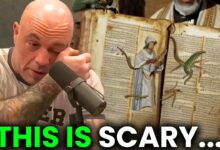Jesus’ Resurrection PROVEN? Shocking New Discovery on the Shroud of Turin!
THE MYSTERY AND POWER OF THE HOLY SHROUD – THE SHROUD OF TURIN
A mysterious image on an ancient cloth has sparked decades of research and debate — this is the Shroud of Turin. For many, it is more than just an ancient relic. It may be the only living evidence of the presence and resurrection of Jesus Christ.
NO WRITINGS — BUT THERE IS THIS CLOTH
Jesus — a man who changed the course of human history — left behind no written records, nor any definitive archaeological evidence of his existence. Yet this cloth appears to bear the image of a crucified man, perfectly matching the biblical description of Jesus’ death and resurrection.
THE STRANGE HISTORY OF THE SHROUD
According to the Gospel of John, burial linens were left behind in the tomb after Jesus rose. Could the Shroud of Turin be one of them?
The shroud was first recorded in 1389, when it was publicly displayed in Lirey, France. From the start, it faced accusations of being a forgery — especially from Bishop Pierre d’Arcis. In 1453, the shroud was handed over to the Royal House of Savoy in Italy, where it remained for centuries. After King Umberto II’s death in 1983, the shroud officially became the property of the Vatican.
AN IMAGE SCIENCE CAN’T EXPLAIN
What makes the Shroud unique is the full-body image on the linen — that of a man who appears to have been crucified in the Roman style. The image possesses an unusual three-dimensional quality, which modern science still cannot replicate or fully explain.
Carbon dating tests in 1988 suggested the cloth dated to the Middle Ages. However, many experts now believe those results were skewed due to repairs and contamination accumulated over time.
A MEDICAL LOOK INTO THE RESURRECTION
Dr. Gilbert R. Lavoie, a physician who studied the Shroud for over 20 years, proposed a bold hypothesis: the image may capture the exact moment of the Resurrection — when Christ rose from the dead.
One detail stood out to him: the hair and body of the man in the image are not lying flat like a corpse, but appear to be upright or suspended. The hair falls to the sides of the face and back, as if the person were standing or floating — inconsistent with a horizontal burial position.
Scientific experiments confirm: if someone is lying down, the body and hair flatten due to gravity. But the Shroud shows no such compression, leading many to believe it reflects a supernatural event.
GEOLOGICAL, MEDICAL, AND ARCHAEOLOGICAL EVIDENCE
-
Traces of soil found on the linen match Jerusalem limestone, found specifically near the Damascus Gate, close to Golgotha, the site of the crucifixion.
-
There are blood stains, shoulder abrasions (possibly from carrying the cross), knee wounds (suggesting a fall), and a blood-and-water stain from a wound in the side — all aligning with the Gospels’ account.
-
The nail wounds appear in the wrists, not the palms — consistent with Roman crucifixion practices (as nails through the wrists could support body weight).
-
An elliptical wound on the side matches the dimensions of a Roman spear.
COINS ON THE EYES AND HIDDEN TEXT ON THE CLOTH
Physicists John and Eric Jumper discovered faint circular shapes over the eyes — possibly ancient coins placed according to Jewish burial customs.
-
The coins match the size and era of Roman currency issued under Pontius Pilate (2 BC – 33 AD).
Additionally, high-resolution imaging revealed faint Greek and Latin text such as “Nazarene” — referring to “Jesus of Nazareth.” This could not have been a medieval forgery, as a 14th-century hoaxer would not have known to use such terminology without the title “Lord.”
The text may have come from ink that transferred from a cloth placed over the face — a practice in Jewish funerals at the time.
NEW DISCOVERY: MOVEMENT WITHIN THE IMAGE
In Polmo, Italy, researchers discovered signs of slight movement in the image — like frames of a film, showing subtle motion in the chest, arms, and legs — as if breath or life was returning. Could the Shroud capture the very moment of resurrection?
THE HEART OF THE CHRISTIAN FAITH
The resurrection of Jesus Christ is not just part of the story — it is the core of the Christian faith. Everything Christians believe — from salvation to eternal life — rests upon this event.
The Gospels describe women visiting the tomb early Sunday morning to find it empty. An angel declares: “He is risen!”
One of the most moving moments occurs in the Gospel of John, when Jesus calls out “Mary,” and she recognizes Him — a deeply personal and emotional encounter. The Resurrection is not just a global event — it’s a personal invitation to every individual.
A LIVING HOPE
From the image on the cloth, to the empty tomb, to the post-resurrection appearances — Jesus demonstrated that He had conquered death. And He promised to return in glory.
Until that day, the power of the Resurrection lives in the hearts of believers — offering forgiveness, hope, and new life.




